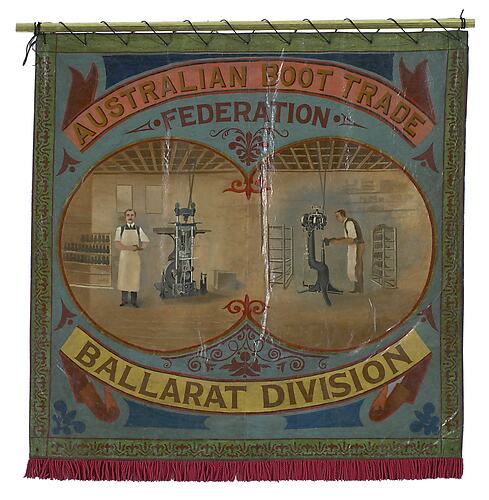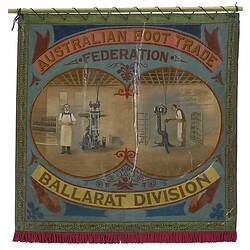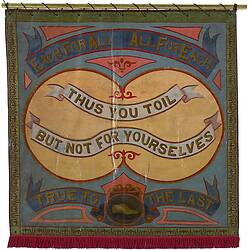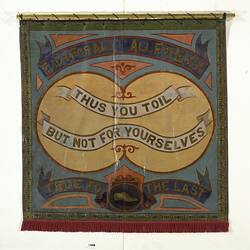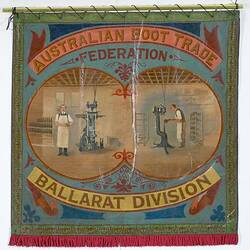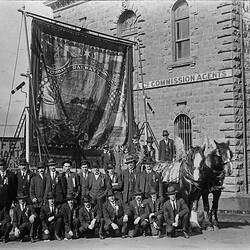Summary
This canvas banner was painted by Fred Spielvogel circa 1905 for the Australian Boot Trade Employees Federation, Ballarat Branch.
On 5 March 1905 the Ballarat Eight Hours' Day Organising Committee agreed to organise entertainments with a view to raising funds to commission a banner for the Bootmakers' Union (Ballarat Star, 6 March 1905). On 11 April the Ballarat Courier reported on a profoundly rainy Ballarat Eight Hours' Day procession: 'The bootmakers with their new banner looking spic and span it had just emerged from the studio of the artist Mr Fred Spielvogel, and on it were representations of up-to-date boot-producing machinery, came next.'
Action taken by stonemasons on 21 April 1856 led to the establishment of the Eight Hour Day, with the government agreeing that workers employed on public works should enjoy an eight hour day with no loss of pay. It was a world first and became emblematic of the rights of labour. In recognition of the significance of this achievement, April 21 was made a public holiday in 1879 and commemorative marches were held each year from 1879 until 1951. The Eight Hour Day holiday was renamed Labour Day in 1934. In 1955 the Labour Day march and celebrations were replaced by Moomba celebrations.
Physical Description
Oil painted on canvas, wool fringe. Side A: Text frames two images of bootmakers: one standing facing us, the other at work at boot making machinery. Side B: Predominantly text, with an image of a wooden shoe last along the bottom edge.
More Information
-
Collection Names
-
Collecting Areas
Public Life & Institutions, Working Life & Trades, Clothing & Textiles
-
Acquisition Information
Loan & Subsequent Donation from Victorian Branch, Textile, Clothing & Footwear Union of Australia, University of Melbourne Archives (The), Dec 1998
-
Acknowledgement
Donated by the Textile Clothing & Footwear Union of Australia, Victorian Branch.
-
Artist
Mr Fred Spielvogel, Ballarat, Victoria, Australia, post 1905
-
Commissioned By
Australian Boot Trade Employees' Federation (ABTEF), Australia, post 1905
-
Inscriptions
Painted side A: AUSTRALIAN BOOT TRADE/ FEDERATION/ BALLARAT DIVISION Painted side B: EACH FOR ALL ALL FOR EACH/ THUS YOU TOIL/ BUT NOT FOR YOURSELVES/ TRUE TO THE LAST
-
Classification
-
Category
-
Discipline
-
Type of item
-
Overall Dimensions
246 cm (Width), 242 cm (Height)
-
Maximum dimensions
2420 mm (Width), 2460 mm (Height)
Measurement From Conservation.
-
Keywords
8 Hours Day Movement, Boot & Shoemaking Industry, Footwear Industry, Trade Unions, Workers Rights, Working Life, Making History - Eight Hour Day
